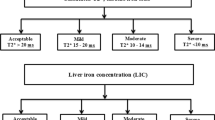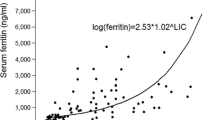Abstract
Background
Cardiac and hepatic magnetic resonance imaging evaluation during treatment can tailor physicians’ chelation therapy titrations.
Aim
The aim of the study was to assess the relationship of cardiac and hepatic T2* values with chelation therapy in patients with transfusion-dependent thalassemia (TDT).
Methods
A total of 106 patients with TDT who were followed up in Istanbul Medical Faculty Thalassemia Center were evaluated for the study. Forty-eight (45%) patients with TDT had more than one consecutive MRI examination. The patients were divided into three subgroups according to the cardiac T2* values as the high-risk group (T2* MRI < 10 ms), medium-risk group (T2* MRI 10-20 ms), and the low-risk group (T2* MRI > 20 ms).
Results
The majority of patients used DFX (deferasirox) (79%) and deferiprone (DFP) (17%). Approximately 80% of patients according to cardiac T2* value and 40% of patients according to hepatic T2* value were initially in the low-risk group. Patients with follow-up MRI examinations exhibited significant improvement in liver iron concentration, which correlated with an increase in hepatic T2* values. The decrease of liver iron concentration was prominent in the DFX group (p < 0.01). The serum ferritin level was significantly correlated with liver iron concentrations (rs = 0.65, p < 0.001), hepatic T2* value (rs = − 0.62, p < 0.001), but not with cardiac T2* value (rs = − 0.20, p = 0.07).
Conclusion
Cardiovascular and hepatic MRI is a useful follow-up tool during the assessment of risk groups and chelation therapy of patients with TDT. Consecutive MRI tests showed good monitoring of cardiac and liver iron overload.
Similar content being viewed by others
Abbreviations
- NTDT:
-
Non-transfusion-dependent thalassemia
- TDT:
-
Transfusion-dependent thalassemia
- MRI:
-
Magnetic resonance imaging
- DFX:
-
Deferasirox
- DFP:
-
Deferiprone
- DFO:
-
Deferoxamine
- LIC:
-
Liver iron concentration
References
Viprakasit V, Origa R (2014) Genetic basis, pathophysiology and diagnosis. In: Cappellini MD, Cohen A, Porter J, Taher A, Viprakasit V (eds). Guidelines for the management of transfusion-dependent thalassemia (TDT), 3rd edn. Nicosia:Thalassaemia International Federation (TIF) Publication, No. 20, pp 14–26
Baksi AJ, Pennell DJ (2014) Randomized controlled trials of iron chelators for the treatment of cardiac siderosis in thalassaemia major. Front Pharmacol 5:217
Borgna-Pignatti C, Cappellini MD, De Stefano P et al (2006) Cardiac morbidity and mortality in deferoxamine or deferiprone-treated patients with thalassemia major. Blood 107:3733–3737
Carpenter JP, Roughton M, Pennell DJ (2013) International survey of T2* cardiovascular magnetic resonance in beta-thalassemia major. Haematologica 98(9):1368–1374
Wood JC (2014) Use of magnetic resonance imaging to monitor iron overload. Hematol Oncol Clin N Am 28(4):747–764
Kirk P, Raughton M, Porter JB et al (2009) Cardiac T2* magnetic resonance for prediction of cardiac complications in thalassemia major. Circulation 120:1961–1968
Auger D, Pennell DJ (2016) Cardiac complications in thalassemia major. Ann N Y AcadSci 1368(1):56–64
Wood JC, Enriquez C, Ghugre N et al (2005) MRI R2 and R2* mapping accurately estimates hepatic iron concentration in transfusion-dependent thalassemia and sickle cell disease patients. Blood 106:1460–1465
Wood JC (2011) Impact of iron assessment by MRI. Hematol Am Soc Hematol Educ Program 2011:443–450
Maira D, Cassinerio E, Marcon A et al (2017) Progression of liver fibrosis can be controlled by adequate chelation in transfusion-dependent thalassemia (TDT). Ann Hematol. https://doi.org/10.1007/s00277-017-3120-9 (Epub ahead of print)
Deugnier Y, Turlin B, Ropert M et al (2011) Improvement in liver pathology of patients with β-thalassemia treated with deferasirox for at least 3 years. Gastroenterology 141(4):1202–1211
Wahidiyat PA, Liauw F, Sekarsari D et al (2017) Evaluation of cardiac and hepatic iron overload in thalassemia major patients with T2* magnetic resonance imaging. Hematology 22(8):501–507
Pepe A, Meloni A, Capra M et al (2011) Deferasirox, deferiprone and desferrioxamine treatment in thalassemia major patients: cardiac iron and function comparison determined by quantitative magnetic resonance imaging. Haematologica 96(1):41–47
Puliyel M, Sposto R, Berdoukas VA et al (2014) Ferritin trends do not predict changes in total body iron in patients with transfusional iron overload. Am J Hematol 89:391–394
Westwood MA, Anderson LJ, Firmin DN et al (2003) Interscanner reproducibility of cardiovascular magnetic resonance T2* measurements of tissue iron in thalassemia. J MagnReson Imaging 18:616–620
Jensen PD, Jensen FT, Christensen T et al (2001) Indirect evidence for the potential ability of magnetic resonance imaging to evaluate the myocardial iron content in patients with transfusional iron overload. MAGMA 12(2–3):153–166
Chouliaras G, Berdoukas V, Ladis V et al (2001) Impact of magnetic resonance imaging on cardiac mortality in thalassemia major. J Magn Reson Imaging 34(1):56–59
Pepe A, Meloni A, Rossi G et al (2013) Cardiac and hepatic iron and ejection fraction in thalassemia major: multicentre prospective comparison of combined deferiprone and deferoxamine therapy against deferiprone or deferoxamine monotherapy. J Cardiovasc Magn Reson 15:1
Fragasso A, Ciancio A, Mannarella C et al (2011) Myocardial iron overload assessed by magnetic resonance imaging (MRI)T2* in multi-transfused patients with thalassemia and acquired anemias. Eur J Intern Med 22(1):62–65
Farhangi H, Badiei Z, Moghaddam HM et al (2017) Assessment of heart and liver iron overload in thalassemia major patients using T2* magnetic resonance imaging. Indian J Hematol Blood Transfus 33(2):228–234
Akcay A, Salcioglu Z, Oztarhan K et al (2014) Cardiac T2* MRI assessment in patients with thalassaemia major and its effect on the preference of chelation therapy. Int J Hematol 99(6):706–713
Pennell DJ, Porter JB, Cappellini MD et al (2012) Deferasirox for up to 3 years leads to continued improvement of myocardial T2* in patients with β-thalassemia major. Haematologica 97(6):842–848
Acknowledgement
We gratefully thank Mr. David Chapman for kindly providing language revision.
Author information
Authors and Affiliations
Corresponding author
Ethics declarations
Conflict of interest
All authors declare that they have no conflict of interest.
Ethical approval
This study was approved by the Institutional Review Board (Istanbul University, Istanbul Medical Faculty Clinical Research Ethics Committee).
Rights and permissions
About this article
Cite this article
Karakas, Z., Yilmaz, Y., Bayramoglu, Z. et al. Magnetic resonance imaging during management of patients with transfusion-dependent thalassemia: a single-center experience. Radiol med 123, 572–576 (2018). https://doi.org/10.1007/s11547-018-0889-0
Received:
Accepted:
Published:
Issue Date:
DOI: https://doi.org/10.1007/s11547-018-0889-0




